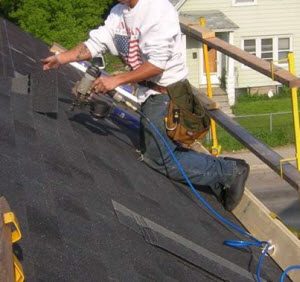While falls from roofs are a major hazard in the general construction industry, hazards posed by hot work during built-up roofing are also significant. With warm weather approaching in much of the country, roofing work will pick up, and this is a good time for roofing employers to review their practices to protect roofers. Several OSHA regulations apply to built-up roofing; the primary intent is to prevent fires and mishandling of hot tar that can result in burn injuries.

Built-up roofing involves application of multiple layers of roofing material, usually bitumen (hot asphalt or tar) between roofing felts. When the layering is complete, a top surface of gravel is typically applied. Properly constructed, the multiple layers provide excellent and long-lasting waterproofing. Built-up roofing is appropriate for flat or minimum-pitch roofs and is most commonly used for commercial structures.
Applicable Regs
In a 2015 document, Protecting Roofing Workers, OSHA notes that hot tar used in built-up roofing reaches 500°F. Mishandling can result in severe burns and fires; also, a kettle that catches fire can explode if the tar reaches a flash point. OSHA emphasizes the following regulations:
- Employers must develop a fire protection program that includes provisions for required firefighting equipment at their jobsites (29 CFR 1926.150(a)(1)).
- Employers must have fire extinguishers rated not less than 10B (a 10B extinguisher can extinguish a fire covering about 10 square feet (ft)) within 50 ft of wherever more than 5 gallons of flammable or combustible liquids or 5 pounds of flammable gas are being used on the jobsite (29 CFR 1926.150(c)(1)(vi)). Employers should also ensure that workers follow the precautions specified by the manufacturer of the bitumen and the kettle.
- Employers must ensure that workers are trained to operate equipment safely and to identify and avoid hazards (29 CFR 1926.20(b) (4) and 29 CFR 1926.21(b)(2)).
- Because of the nature of built-up roofing work, employers must provide necessary personal protective equipment. Working around kettles, tankers, luggers, and mop buckets can lead to spills and splashes from hot tar. To protect workers from burns, proper clothing like gloves, work boots, long-sleeved cotton shirts, long cotton pants without cuffs, and eye protection or face shields must be provided.
Torches and Flammable Adhesives
OSHA also notes that torches used in applied roofing can reach temperatures of 2,000°F at the torch end. OSHA states:
“When heat from the torch is improperly applied to the roofing ply, it can conduct enough heat to ignite combustible materials underneath, such as wood decking or trusses, without the knowledge of the roofer. Preconstruction surveys, following the ply manufacturer’s application techniques, and posting a fire watch can prevent a catastrophic loss and personal injury from fires. Regular fire-watch inspections should be done throughout the day by a competent person and for a minimum of two hours starting when the last torch is extinguished on a roof. Inspections should include the roof’s entire field, flashings and the underside of the roof deck.”
OSHA’s document also describes other hot work hazards for roofing workers, including mishandling of propane tanks and working with flammable solvent-based adhesives on single-ply roofs.
